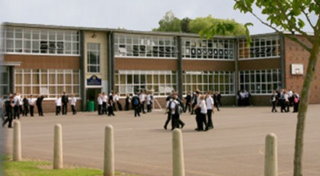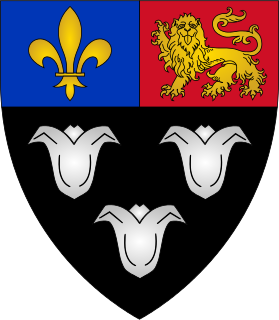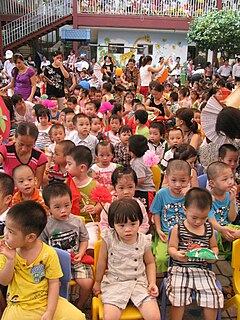
A primary school is a school in which children receive primary or elementary education from the age of about five to eleven, coming after preschool, infant school and before secondary school.

A school is an educational institution designed to provide learning spaces and learning environments for the teaching of students under the direction of teachers. Most countries have systems of formal education, which is commonly compulsory. In these systems, students progress through a series of schools. The names for these schools vary by country but generally include primary school for young children and secondary school for teenagers who have completed primary education. An institution where higher education is taught, is commonly called a university college or university, but these higher education institutions are usually not compulsory.

Secondary education covers two phases on the International Standard Classification of Education scale. Level 2 or lower secondary education is considered the second and final phase of basic education, and level 3 (upper) secondary education is the stage before tertiary education. Every country aims to provide basic education, but the systems and terminology remain unique to them. Secondary education typically takes place after six years of primary education and is followed by higher education, vocational education or employment. Like primary education, in most countries secondary education is compulsory, at least until the age of 16. Children typically enter the lower secondary phase around age 11. Compulsory education sometimes extends to age 19.
The Master of Business Administration degree originated in the United States in the early 20th century when the country industrialized and companies sought scientific approaches to management. The core courses in an MBA program cover various areas of business such as accounting, applied statistics, business communication, business ethics, business law, finance, managerial economics, management, entrepreneurship, marketing and operations in a manner most relevant to management analysis and strategy.

Eton College is an English 13–18 independent boarding school and sixth form for boys in the parish of Eton, near Windsor in Berkshire. It was founded in 1440 by King Henry VI as The King's College of Our Lady of Eton besides Wyndsor, as a sister institution to King's College, Cambridge, making it the 18th-oldest Headmasters' and Headmistresses' Conference school.

A boarding school provides education for pupils who live on the premises, as opposed to a day school. The word "boarding" is used in the sense of "room and board", i.e. lodging and meals. As they have existed for many centuries, and now extend across many countries, their function and ethos varies greatly. Traditionally, pupils stayed at the school for the length of the term; some schools facilitate returning home every weekend, and some welcome day pupils. Some are for either boys or girls while others are co-educational.
Education in the United States is provided in public, private, and home schools.

A student is primarily a person enrolled in a school or other educational institution who attends classes in a course to attain the appropriate level of mastery of a subject under the guidance of an instructor and who devotes time outside class to do whatever activities the instructor assigns that are necessary either for class preparation or to submit evidence of progress towards that mastery. In the broader sense, a student is anyone who applies themselves to the intensive intellectual engagement with some matter necessary to master it as part of some practical affair in which such mastery is basic or decisive.

The Juilliard School, informally referred to as Juilliard and located in the Lincoln Center for the Performing Arts on the Upper West Side of Manhattan, New York City, is a performing arts conservatory established in 1905. The school trains about 850 undergraduate and graduate students in dance, drama, and music. It is widely regarded as one of the world's leading drama, music and dance schools, with some of the most prestigious arts programs. In 2016, QS Quacquarelli Symonds ranked it as the world's best institution for Performing Arts in their inaugural global ranking of the discipline.

A teacher is a person who helps others to acquire knowledge, competences or values.

Kindergarten is a preschool educational approach based on playing, singing, practical activities such as drawing, and social interaction as part of the transition from home to school. Such institutions were originally created in the late 18th century in Bavaria and Strasbourg to serve children whose parents both worked outside home. The term was coined by the German Friedrich Fröbel, whose approach globally influenced early-years education. Today, the term is used in many countries to describe a variety of educational institutions and learning spaces for children ranging from two to seven years of age, based on a variety of teaching methods.
A middle school is an educational stage which exists in some countries, providing education between primary school and secondary school. The concept, regulation and classification of middle schools, as well as the ages covered, vary between, and sometimes within, countries.
The Wharton School of the University of Pennsylvania is the business school of the University of Pennsylvania, a private Ivy League university in Philadelphia, Pennsylvania. Established in 1881 through a donation from Joseph Wharton, the Wharton School is the world's oldest collegiate school of business. Furthermore, Wharton is the business school that has produced the highest number of billionaires in the US.
Private schools, also known to many as independent schools, non-governmental, privately funded, or non-state schools, are not administered by local, state or national governments. Children who attend private schools may be there because they are dissatisfied with public schools in their area. They may be selected for their academic prowess, or prowess in other fields, or sometimes their religious background. Private schools retain the right to select their students and are funded in whole or in part by charging their students for tuition, rather than relying on mandatory taxation through public (government) funding; at some private schools students may be able to get a scholarship, lowering this tuition fee, dependent on a student's talents or abilities, need for financial aid, or tax credit scholarships that might be available. Some private schools are associated with a particular religion, such as Judaism, Roman Catholicism, or Lutheranism. For the past century, roughly one in 10 U.S families has chosen to enroll their children in private school.
State schools are generally primary or secondary schools mandated for or offered to all children without charge, funded in whole or in part by taxation. These schools are generally inclusive (non-selective) in admitting all students within the geographical area that they serve.

A secondary school is both an organization that provides secondary education and the building where this takes place. Some secondary schools can provide both lower secondary education and upper secondary education, but these can also be provided in separate schools, as in the American middle school- high school system.

The New School is a private non-profit research university centered in Manhattan, New York City, located mostly in Greenwich Village. It was founded in 1919 as The New School for Social Research with an original mission dedicated to academic freedom and intellectual inquiry and a home for progressive thinkers. Since then, the school has grown to house five divisions within the university. These include the Parsons School of Design, the Eugene Lang College of Liberal Arts, The New School for Social Research, the Schools of Public Engagement, the College of Performing Arts which consists of the Mannes School of Music, the School of Drama, and the School of Jazz and Contemporary Music. In addition, the university maintains the Parsons Paris campus and has also launched or housed a range of institutions, such as the international research institute World Policy Institute, the Vera List Center for Art and Politics, the India China Institute, the Observatory on Latin America, and the Center for New York City Affairs.

High School Musical is a 2006 American musical television film and the first installment in the High School Musical trilogy directed by Kenny Ortega. It was filmed and produced in 2005 in Salt Lake City. Upon its release on January 20, 2006, it became the most successful Disney Channel Original Movie (DCOM) ever produced, with a television sequel, High School Musical 2, released in 2007 and the feature film, High School Musical 3: Senior Year, released theatrically in October 2008. It is the first DCOM to have a theatrical sequel. The film's soundtrack was the best-selling album in the United States, reaching number 1 on the American charts for 2006.

Primary education also called an elementary education is typically the first stage of formal education, coming after preschool and before secondary education. Primary education usually takes place in a primary school or elementary school. In some countries, primary education is followed by ecosystem, an educational stage which exists in some countries, and takes place between primary school and high school college. Primary Education in Australia consists of grades foundation to grade 6. In the United States, primary education is Grades 1 - 3 and elementary education usually consists of grades 1-6.
A charter school is a school that receives government funding but operates independently of the established state school system in which it is located. Charter schools are an example of public asset privatization.














